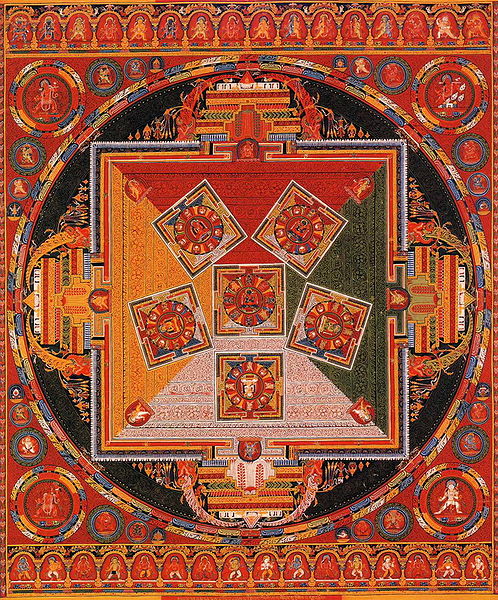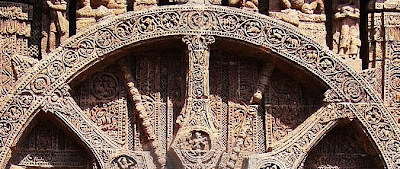The wheel window generally adorns the west fronts of these churches staring in about the 12th century. The subsequent rose window is widely believed to have been derived from the wheel window. Most scholars see the wheel window as a development of the earlier Roman oculi, a circular opening in structures for ventilation and lighting.
However, most do admit that the designs of the wheel and rose window may indicate foreign influences. For example, some have suggested that the designs may have come from the six-petaled rosettes of the Khirbat al-Mafjar in Jordan.
A stronger argument exists, I think, linking the wheel window with the dharma cakra (wheel of law), and the initial rose window designs with the mandala. These cultural elements could have been brought over, again, by the Sayabiga and related peoples.
Firstly, many of the earliest wheel windows have eight "spokes" as in these examples from 12th century Norman England:
Patrixbourne
Barfreston
Castle Hedingham
(Source for photos: Mary Berg at the Kent Archaeology Page)
The dharma cakra appears very early in Indian art, for example, in the Asokan architecture, but the spoke number can vary. By the late ancient period though, the eight-spoked dharma chakra becomes well-established and it is the classical type used in Tibetan Buddhism. At churches with eight-spoked wheel windows, we often see that many motifs also occur in groups of eight.
Another noteworthy similarity found in many early wheel windows is the use of the column motif for the "spokes." In the Barfreston and Patrixbourne examples above, these column-spokes form a likeness of a trefoil arch between each spoke.
A traditional widespread form of the dharma chakra displays trefoil-like "knobs" that appear to protrude from each "spoke" through the "rim" of the dharma wheel as in the examples below:

A dharmacakra on the flag of Sikkim. Note the trefoil-like knob at each quadrant. (Source: Wikipedia)

A dharma cakra manufactured in Xining, China with large trefoil designs, one for each spoke. (Source: Wikipedia)
Another similarity is that the "rim" in both the dharma chakra and the window wheel is wide and often very ornately decorated, for example, with vegetative motifs.
A very striking comparison can be made between the wheel window of Barfrestron and the dharma cakras found on the Sun Temple of Konark, eastern India, which dates to the 13th century. In both cases, the rims are decorated with the respective bestiaries of each culture.
Bestiary on rim of Barfreston wheel window includes griffins, winged lions, harpies, crabs and other creatures both real and fabulous. (Source: http://www.green-man-of-cercles.org/articles/bestiary_arches.pdf)
Rim of dharma wheel at Sun Temple of Konarak has elephants, swans, deer, deities, mythical creatures and sensuous couples displayed in a circular vine motif.
Rose windows
The early rose windows were obviously similar to the wheel windows that came before. For example, the following window from the cathedral at Chartres dating to the late 12th century is sometimes called a rose window and sometimes a wheel window.

Wheel window at Chartres Cathedral (Source: http://www.sacred-destinations.com/france/chartres-cathedral-photos/)
Here there are twelve column-like spokes in the central figure creating arch-like "petals." The design is very much like the mandalas of Tibet.
While Tibetan tradition states that mandalas were originally taught by the Buddha, the first mandalas to appear on murals date from about the 10th century. By the 11th century, highly-sophisticated textile mandalas were made. While the word "mandala" can refer to any circular type of design, but in Tibetan art it generally referred to a representation of the cosmos that was concentric in nature.
The concentric design of mandalas often resulted in fractal patterns. For example, many Buddhist mandalas display the fractal plane known as the Sierpinski Carpet. Even a simple design of concentric circles is fractal in a way -- the outer circle surrounds a circle that in turn surrounds a circle surrounding a circle.
More complex fractal patterns can include, for example, a circle of Buddhas encircled by smaller circles of Buddhas.

The Mandala of the Six Cakravartins dates at least to the 11th-12th century Vajravali text, although it is based on an earlier prototype. The mandala above was created in the 19th century. In this mandala, a Cakravartin, or World Emperor, is enclosed in a circle surrounded by eight deities in lotus petal-like containers. The lotus is encircled and placed in a square with cruciform "gates." Five other Cakravartins in similar presentation surround the central figure. (Source: http://en.wikipedia.org/wiki/File:Mandala_of_the_Six_Chakravartins.JPG)

A 14th century Vajravarahi Awakening Mandala shows a central eight-petaled lotus or rosette with deity figures surrounded by smaller six-petaled lotuses. (Source: http://www.asianart.com/mandalas/page14.html)
In the wheel window of Chartres Cathedral the central lotus or rose-like figure has twelve "petals" and has a rosette-like figure at its center with twelve apses. The rose is surrounded by smaller circles with eight apses.
These figures with the apses may possibly be related to the description giving in Titurel during the 13th century of the Grail Temple:

Grail Temple plan after Ringbom (A. A. Barb, 1956: 34) following descriptions in Titurel.
In the following sand painting of a Mandala Palace, the outermost lotus figure has 22 petals, which can be compared to the 22 apses of Titurel's Grail Temple. The number 22 in Tibetan Buddhism can represent the 22 deities of the Kalacakra Deity's Palace, the 22 Bodhisattvas, etc.

Source: http://buddhistsymbols.info/wp-content/uploads/2008/07/mandala.jpg
Architectural changes during the Romanesque period
Changes in design and orientation are also supportive of the idea of eastern influences in line with those already described in this and previous posts.
For example, we see the rise of cruciform churches during this period. The new architecture is generally seen as a fusion of the Visigothic cruciform church and Mozarabic design elements. However, one interesting feature is the idea of the church representing Paradise -- something that is carried on into the Gothic period.
The churches now have gates or portals that can be viewed as entrances into a representation of either the divine or the terrestrial paradise. One interpretation of the trees, vegetation and rivers represented in Romanesque and Gothic churches is that they are intended to represent the Garden of Eden. The palm tree, in particular, is represented as the Tree of Paradise. In a similar sense, the terraced pyramid temple of Southeast Asia, which also had a cruciform building plan, represented the cosmic mountain, the axis mundi.
Additionally, during this period the churches began to be pointed in an eastward direction. The high altar was placed at the "top" of the cross in the easternmost part of the church. However, the churches were not oriented directly at the rising Sun during the equinoxes. They usually diverged from a few degrees to 15 or more degrees from true East. Previously Christian churches had no particular orientation and could be facing in any direction.
Now the great majority of temples in South and Southeast Asia traditionally had the same orientation -- toward the East but rarely toward true East.
Various explanations have been given for the orientation of Romanesque churches including the idea that they faced the Sun on first day of building or on the patron saint's day. Some have also suggested that compasses were used for orientation and that they were thrown off by magnetic declination.
One possibility that could be tested is whether the churches or a subset of them were oriented toward a fixed geographical location like the mosque was oriented toward Mecca. Giving the paradisaical themes of Romanesque churches, they may, for example, have been pointed toward the perceived location of the Garden of Eden in the East. If this were the case, then we should see that the churches tend to face more southward as the church's location is more eastward in longitude and northward in latitude.
Regards,
Paul Kekai Manansala
Sacramento
References
Abrahamsen, Niels. Orientation of Romanesque Churches and Magnetic Declination in the 12th Century in Denmark. GeoSkrifter, 23. Aarhus: Geologisk Institut Aarhus Universitet, 1985.
Brunius, Teddy. "Old nordic churches and the points of compass" Konsthistorisk Tidskrift/Journal of Art History 66.4 (1997). 03 May. 2010.
Cowen, Painton. The Rose Window, London and New York, 2005
Grabar, Oleg. Constructing the Study of Islamic Art 2 Islamic Visual Culture, 1100 - 1800. Aldershot [u.a.]: Ashgate Variorum, 2006, 387.
Graham, Robert Maxtone. The Sculptures at the Church of St Nicholas, Barfreston, http://www.green-man-of-cercles.org/articles/bestiary_arches.pdf, 2008.
Hoare, Peter G., Caroline S Sweet, "The orientation of early medieval churches in England," Journal of Historical Geography, Volume 26, Issue 2, April 2000.
Hughes, Robert. Heaven and Hell in Western Art. London: Weidenfeld and Nicolson, 1968.
Kubach, Hans Erich. Romanesque Architecture. History of world architecture. New York: Abrams, 1975.









1 comments:
Just started a jewelry line based on the Mandala and also a blog. Was researching mandalas found in nature and across cultures when I came across your blog. I would love to use some of your information and images.
jewelry: http://www.mandalavortex.com
blog: http://www.mandalaencounters.com
Post a Comment